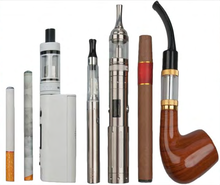
Back سيجارة إلكترونية Arabic Pitu electrónicu AST Elektron siqaret Azerbaijani الکترونیک سیقار AZB Електронна цигара Bulgarian Cigarreta electrònica Catalan Elektronická cigareta Czech Sigarét electronig Welsh E-cigaret Danish Elektrische Zigarette German


An electronic cigarette (e-cigarette), or vape,[note 1][1] is a device that simulates tobacco smoking. It consists of an atomizer, a power source such as a battery, and a container such as a cartridge or tank. Instead of smoke, the user inhales vapor.[2] As such, using an e-cigarette is often called "vaping".[3] The atomizer is a heating element that vaporizes a liquid solution called e-liquid,[4] which quickly cools into an aerosol of tiny droplets, vapor and air.[5] The vapor mainly comprises propylene glycol and/or glycerin, usually with nicotine and flavoring. Its exact composition varies, and depends on several things including user behavior.[note 2]
E-cigarettes are activated by taking a puff or pressing a button.[3][6] Some look like traditional cigarettes,[3][7] and most kinds are reusable.[note 3]
Nicotine is highly addictive.[9][10][11] Users become physically and psychologically dependent.[12] Scientists do not know how harmful e-cigarettes are over the long-term[13][14] because it is hard to separate the effects of vaping from the effects of smoking when so many people both vape and smoke.[note 4][15] E-cigarettes have not been used widely enough or for long enough to be sure.[16][17][18]
Vaping is likely far less harmful than smoking, but still harmful.[19][20][21] E-cigarette vapor contains far fewer toxins than cigarette smoke, and at much lower concentrations. The vapor contains traces of harmful substances not found in cigarette smoke.[21] E-cigarettes containing nicotine are more effective than nicotine replacement therapy (NRT) for smoking cessation.[22][23] However, e-cigarettes have not been subject to the same rigorous testing that most nicotine replacement therapy products have,[24] and health warnings may encourage a smoker to quit vaping.[25]
- ^ a b "Vaporizers, E-Cigarettes, and other Electronic Nicotine Delivery Systems (ENDS)". United States Food and Drug Administration. 14 February 2020.
 This article incorporates text from this source, which is in the public domain.
This article incorporates text from this source, which is in the public domain.
- ^ a b Cheng, T. (2014). "Chemical evaluation of electronic cigarettes". Tobacco Control. 23 (Supplement 2): ii11–ii17. doi:10.1136/tobaccocontrol-2013-051482. ISSN 0964-4563. PMC 3995255. PMID 24732157.
- ^ a b c Cite error: The named reference
Orellana-Barrios2015was invoked but never defined (see the help page). - ^ Cite error: The named reference
Weaver2014was invoked but never defined (see the help page). - ^ David, Grégory; Parmentier, Evelyne A.; Taurino, Irene; Signorell, Ruth (December 2020). "Tracing the composition of single e-cigarette aerosol droplets in situ by laser-trapping and Raman scattering". Scientific Reports. 10 (1): 7929. Bibcode:2020NatSR..10.7929D. doi:10.1038/s41598-020-64886-5. PMC 7220912. PMID 32404884.
- ^ Cite error: The named reference
Rahman2014was invoked but never defined (see the help page). - ^ Pepper, J. K.; Brewer, N. T. (2013). "Electronic nicotine delivery system (electronic cigarette) awareness, use, reactions and beliefs: a systematic review". Tobacco Control. 23 (5): 375–384. doi:10.1136/tobaccocontrol-2013-051122. ISSN 0964-4563. PMC 4520227. PMID 24259045.
- ^ a b Drope, Jeffrey; Cahn, Zachary; Kennedy, Rosemary; Liber, Alex C.; Stoklosa, Michal; Henson, Rosemarie; Douglas, Clifford E.; Drope, Jacqui (November 2017). "Key issues surrounding the health impacts of electronic nicotine delivery systems (ENDS) and other sources of nicotine". CA: A Cancer Journal for Clinicians. 67 (6): 449–471. doi:10.3322/caac.21413. ISSN 0007-9235. PMID 28961314. S2CID 32928770.
- ^ "Policy on Electronic Nicotine Delivery Systems (ENDS)" (PDF). American Academy of Pediatrics. 2020. Retrieved 13 November 2022.
- ^ "Position Statements on e-cigarettes". American Academy of Otolaryngology-Head and Neck Surgery (AAO-HNS). 21 April 2021. Archived from the original on 13 November 2022. Retrieved 13 November 2022.
- ^ Schraufnagel, Dean E.; Blasi, Francesco; Drummond, M. Bradley; Lam, David C. L.; Latif, Ehsan; Rosen, Mark J.; Sansores, Raul; Van Zyl-Smit, Richard (15 September 2014). "Electronic Cigarettes. A Position Statement of the Forum of International Respiratory Societies". American Journal of Respiratory and Critical Care Medicine. 190 (6): 611–618. doi:10.1164/rccm.201407-1198PP. ISSN 1073-449X. PMID 25006874. S2CID 43763340. Retrieved 13 November 2022.
- ^ Miyasato, K. (March 2013). "[Psychiatric and psychological features of nicotine dependence]". Nihon Rinsho. Japanese Journal of Clinical Medicine (in Japanese). 71 (3): 477–481. PMID 23631239.
- ^ Marques, Patrice; Piqueras, Laura; Sanz, Maria-Jesus (December 2021). "An updated overview of e-cigarette impact on human health". Respiratory Research. 22 (1): 151. doi:10.1186/s12931-021-01737-5. PMC 8129966. PMID 34006276. S2CID 234753956.
the safety of e-cigarette consumption and its potential as a smoking cessation method remain controversial due to limited evidence...the potential long-term effects of e-cigarette consumption have been scarcely investigated.
- ^ Walley, Susan C.; Wilson, Karen M.; Winickoff, Jonathan P.; Groner, Judith (1 June 2019). "A Public Health Crisis: Electronic Cigarettes, Vape, and JUUL". Pediatrics. 143 (6): e20182741. doi:10.1542/peds.2018-2741. PMID 31122947. S2CID 163165584.
Because e-cigarettes have only been marketed for ~10 years... scientific data are limited and will continue to emerge. Because e-cigarette solutions and emissions have been shown to contain nicotine and many of the same harmful toxicants and carcinogens as cigarettes, it is reasonable to assume that there is the potential for similar health effects for e-cigarette use, particularly with emerging data of tobacco toxicant exposure found among e-cigarette users.
- ^ Kim, Sooyong; Selya, Arielle S (12 June 2020). "The Relationship Between Electronic Cigarette Use and Conventional Cigarette Smoking Is Largely Attributable to Shared Risk Factors". Nicotine & Tobacco Research. 22 (7): 1123–1130. doi:10.1093/ntr/ntz157. PMC 7291806. PMID 31680169.
past research remains inconclusive due to heavy confounding between cigarette and e-cigarette use
- ^ Gotts, Jeffrey E; Jordt, Sven-Eric; McConnell, Rob; Tarran, Robert (30 September 2019). "What are the respiratory effects of e-cigarettes?". BMJ. 366: l5275. doi:10.1136/bmj.l5275. PMC 7850161. PMID 31570493.
We reiterate that, to date, no long term vaping toxicological/safety studies have been done in humans; without these data, saying with certainty that e-cigarettes are safer than combustible cigarettes is impossible.
- ^ Benowitz, Neal L.; Burbank, Andrea D. (August 2016). "Cardiovascular toxicity of nicotine: Implications for electronic cigarette use". Trends in Cardiovascular Medicine. 26 (6): 515–523. doi:10.1016/j.tcm.2016.03.001. PMC 4958544. PMID 27079891.
It is difficult to distinguish the independent roles of nicotine vs tobacco combustion products in cigarette smokers because all smokers are exposed to both.
- ^ Bals, Robert; Boyd, Jeanette; Esposito, Susanna; Foronjy, Robert; Hiemstra, Pieter; Jiménez-Ruiz, Carlos A.; Katsaounou, Paraskevi; Lindberg, Anne; Metz, Carlos; Schober, Wolfgang; Spira, Avrum; Blasi, Francesco (February 2019). "Electronic cigarettes: a task force report from the European Respiratory Society". European Respiratory Journal. 53 (2): 1801151. doi:10.1183/13993003.01151-2018. ISSN 0903-1936. PMID 30464018. S2CID 53711734.
The long-term effects of ECIG use are unknown, and there is therefore no evidence that ECIGs are safer than tobacco in the long term. Based on current knowledge, negative health effects cannot be ruled out.
- ^ National Academies of Sciences, Engineering, and Medicine (2018), p. [page needed]: "Laboratory tests of e-cigarette ingredients, in vitro toxicological tests, and short-term human studies suggest that e-cigarettes are likely to be far less harmful than combustible tobacco cigarettes."
- ^ Health and Care Excellence, The National Institute for (30 November 2021). "Recommendations on treating tobacco dependence Tobacco: preventing uptake, promoting quitting and treating dependence. Guidance NICE". www.nice.org.uk. Retrieved 13 November 2022.
use of e‑cigarettes is likely to be substantially less harmful than smoking
- ^ a b Balfour, David J. K.; Benowitz, Neal L.; Colby, Suzanne M.; Hatsukami, Dorothy K.; Lando, Harry A.; Leischow, Scott J.; Lerman, Caryn; Mermelstein, Robin J.; Niaura, Raymond; Perkins, Kenneth A.; Pomerleau, Ovide F.; Rigotti, Nancy A.; Swan, Gary E.; Warner, Kenneth E.; West, Robert (September 2021). "Balancing Consideration of the Risks and Benefits of E-Cigarettes". American Journal of Public Health. 111 (9): 1661–1672. doi:10.2105/AJPH.2021.306416. PMC 8589069. PMID 34410826.
Among potentially toxic substances common to both products, cigarette smoke generally contains substantially larger quantities than e-cigarette aerosol. However, e-cigarette aerosol contains some substances not found in cigarette smoke."
- ^ Lindson, Nicola; Butler, Ailsa R.; McRobbie, Hayden; Bullen, Chris; Hajek, Peter; Begh, Rachna; Theodoulou, Annika; Notley, Caitlin; Rigotti, Nancy A.; Turner, Tari; Livingstone-Banks, Jonathan; Morris, Tom; Hartmann-Boyce, Jamie (8 January 2024). "Electronic cigarettes for smoking cessation". The Cochrane Database of Systematic Reviews. 1 (1): CD010216. doi:10.1002/14651858.CD010216.pub8. ISSN 1469-493X. PMC 10772980. PMID 38189560.
- ^ Lindson, N; Butler, AR; McRobbie, H; Bullen, C; Hajek, P; Begh, R; Theodoulou, A; Notley, C; Rigotti, NA; Turner, T; Livingstone-Banks, J; Morris, T; Hartmann-Boyce, J (8 January 2024). "Electronic cigarettes for smoking cessation". The Cochrane Database of Systematic Reviews. 1 (1): CD010216. doi:10.1002/14651858.CD010216.pub8. PMC 10772980. PMID 38189560. Retrieved 17 April 2024.
- ^ Carpenter, Matthew J.; Wahlquist, Amy E.; Dahne, Jennifer; Gray, Kevin M.; Cummings, K. Michael; Warren, Graham; Wagener, Theodore L.; Goniewicz, Maciej L.; Smith, Tracy T. (September 2023). ""Effect of unguided e-cigarette provision on uptake, use, and smoking cessation among adults who smoke in the USA: a naturalistic, randomised, controlled clinical trial."". eClinicalMedicine. 63: 102142. doi:10.1016/j.eclinm.2023.102142. PMC 10518503. PMID 37753443.
- ^ Cite error: The named reference
Al-HamdaniHopkins2019was invoked but never defined (see the help page).
Cite error: There are <ref group=note> tags on this page, but the references will not show without a {{reflist|group=note}} template (see the help page).